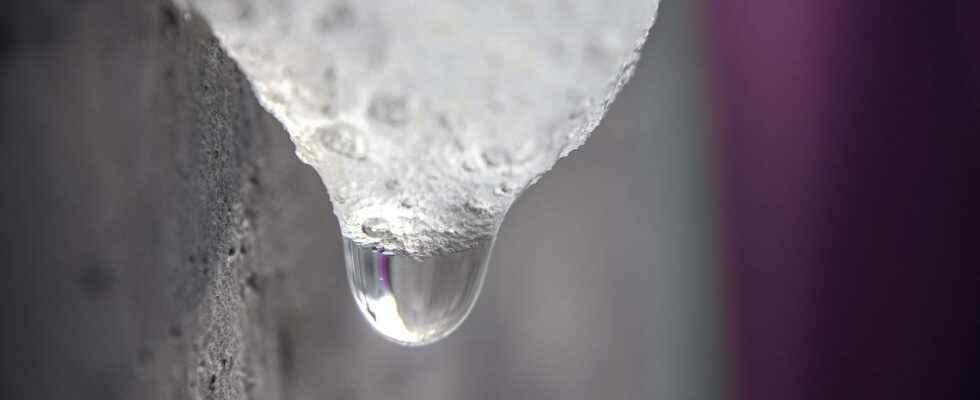Pure water normally freezes at 0 ° C. But under certain conditions, the melting temperature can be significantly lowered. This ice nucleation process is essential in weather phenomena such as cloud formation, or in de-icing technologies. Researchers have reached a new freezing point record, and it may not be the end of it!
You will also be interested
[EN VIDÉO] Why does salt melt snow? When winter arrives, it is not uncommon for the roads to freeze over. In order to prevent accidents, the main roads are often covered with salt, which has the effect of melting the snow. Unisciel and the University of Lille 1 explain to us, during this episode of Kézako, what are the chemical processes that come into play in this situation.
You always learned that the water freezes at 0 ° C? This is not always true, however. For example, 23% salt seawater solidifies only at -21 ° C. There may also be a phenomenon of supercooling, where the water remains liquid in an unstable state. This is what we observe in clouds, where the water suddenly turns into frosted when a plane passes for example. Under certain conditions, water can theoretically remain liquid down to -38 ° C. In 2018, researchers had already succeeded in pushing this limit back to -42.55 ° C (see our previous article, below). Today, a new record at -44 ° C was broken by a team from the University of Houston in the United States, the results of which appeared in the journal Nature Communications.
Nanodrops of only 275 molecules
To achieve this feat, scientists first created tiny water droplets ranging from 150 nanometers (i.e. the size of a particle of flu virus) down to 2 nanometers, which represents only 275 water molecules. In fact, the smaller the drop, the lower the melting point. The 2 nanometer drops thus freeze at -41 ° C. To go even lower, the researchers “wrapped” the drops in octane, a hydrocarbon that they added to the pores of a membrane ofaluminum oxide anodized where the water drops passed. ” We have found that if a water droplet is in contact with a soft interface, the freezing temperature can be considerably lower than that of hard surfaces. Explains Hadi Ghasemi, professor of mechanical engineering at the University of Houston. This approach allows the droplets to take a more rounded shape under a pressure higher, which is essential to prevent the formation of ice crystals at very low temperatures.
A theoretical limit at -123 ° C
To detect the passage from liquid water to solid water, impossible to observe directly at this scale, the researchers analyzed the light emitted in the spectrum infrared and measured the electrical conductance (ice being more conductive than water). Result: the 2 nanometer drops froze at -44 ° C, which sets a new record. It is impossible to know if such conditions are possible in the natural environment, warn the researchers. Theoretically, it is estimated that the nucleation ice can be removed down to -123 ° C when the nanodroplet is confined in a special shape and subjected to strong pressure. But so far, no one has succeeded in creating and observing such droplets.
Anti-icing and weather forecast
This research has many implications, explains Hadi Ghasemi. ” The process of freezing small water droplets plays a vital role in the survival of animals in cold environments, as the formation of frozen water inside a cell leads to its rupture and death. ” The fusion water also plays a key role in climate prediction, cloud forming conditions, cryopreservation of organs and devices exposed to icing conditions such as airplanes and airplanes. wind turbines. Hadi Ghasemi has also previously invented a anti-icing for some applications aerospace.
Record: liquid water at -42.55 ° C
Article by Nathalie Mayer published on 01/11/2018
A few days ago, researchers announced that water was actually made up of two liquids that could be separated. Today, another team tells us that it can remain liquid down to a temperature below -40 ° C. Water, this apparently basic compound, will definitely never cease to amaze us.
Everyone knows, the temperature of solidification of the’pure water is 0 ° C. Pure water, because add a little salt to the water and the temperature may drop. So a salt water up to 23% freezes only from -21 ° C. But this is nothing compared to the record that researchers at theUniversity of Frankfort (Germany). They managed to maintain pure liquid water down to … -42.55 ° C!
In such a situation, when a compound remains liquid at a temperature at which it is normally solid, the physicists talk about supercooling. However, they do not yet know precisely what the underlying mechanisms are. In the case of supercooling water this could, however, among other things, help them to develop more reliable climate models. Because supercooled water drops naturally form in theatmosphere. Airplane pilots know this because it happens that their aircraft, crossing a cloud, sometimes if diffuse that it is invisible, is covered almost instantly with frost, the setting in ice of the supercooled water then being caused by the shock.
A vacuum chamber and a laser
To establish their temperature record, German researchers injected micrometric-sized drops of water into a vacuum chamber. On their journey, these drops have partially evaporated. In doing so, the drops, thus narrowed, cooled in correlation with the decrease in their dimensions.
All that remained was to measure the diameters of the drops to assess their temperature. The researchers achieved this with an unmatched precision of 10 nanometers. By lighting up the drops laser and measuring the position of the resonant peaks of the scattered light.
Interested in what you just read?
.
fs3
